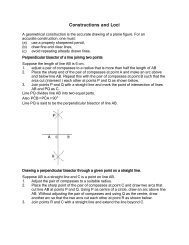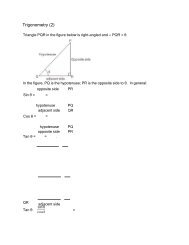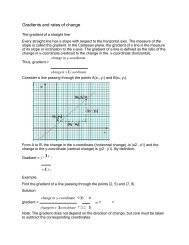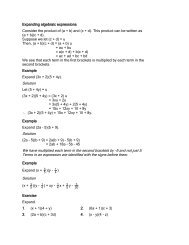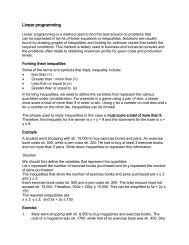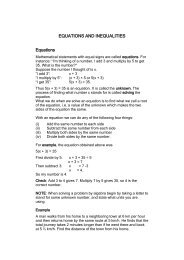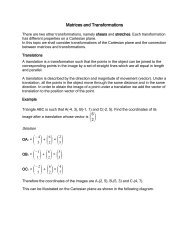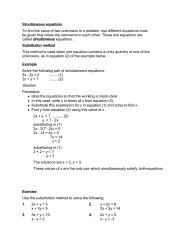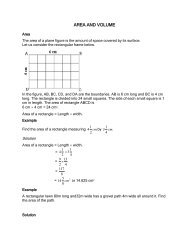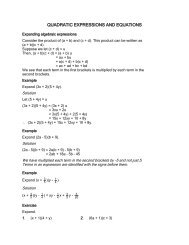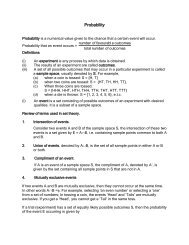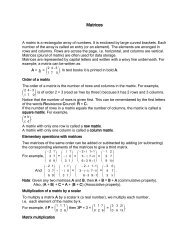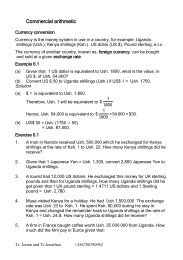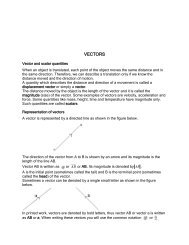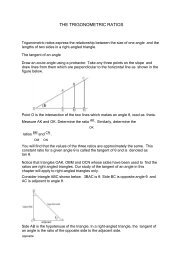bio4
Create successful ePaper yourself
Turn your PDF publications into a flip-book with our unique Google optimized e-Paper software.
The Chemicals of Living Cells<br />
©The Wellcome Trust
2<br />
The chemicals of life<br />
All living organisms are made up of chemical substances<br />
Reactions between these substances keep the cytoplasm<br />
(and the organism) alive. They are living processes.<br />
The chemical substances described in the next series<br />
of slides are carbohydrates, proteins and lipids, but there<br />
are hundreds of others.
Carbohydrates<br />
3<br />
Carbohydrates contain the elements carbon, hydrogen<br />
and oxygen<br />
Familiar carbohydrates are sugar and starch<br />
Glucose, fructose, maltose and sucrose are sugars<br />
Glucose and fructose have the same formula, C 6 H 12 O 6<br />
Sucrose and maltose have the same formula, C 12 H 22 O 11<br />
Carbohydrates provide the main source of energy for<br />
respiration in living organisms
4<br />
Glucose C 6 H 12 O 6<br />
C<br />
HO<br />
C<br />
HO<br />
C<br />
H<br />
C<br />
O<br />
HO<br />
H<br />
H<br />
C<br />
C<br />
C<br />
H<br />
OH<br />
OH<br />
C<br />
C<br />
C<br />
C<br />
5 of the carbon atoms may<br />
be arranged in a ring<br />
C<br />
H 2 OH<br />
A glucose molecule as a<br />
straight chain<br />
This molecule is often represented<br />
simply as a hexagon
Other carbohydrates<br />
5<br />
2 molecules of glucose can<br />
join together to form a<br />
molecule of maltose<br />
sucrose is formed when<br />
a molecule of glucose and<br />
a molecule of fructose combine<br />
maltose<br />
Starch and cellulose are<br />
formed from hundreds of<br />
glucose molecules joined<br />
to form a long chain<br />
part of a starch<br />
molecule
Proteins<br />
6<br />
Proteins are made up of carbon, hydrogen and oxygen<br />
molecules but with the addition of nitrogen<br />
Carbohydrates are made up of glucose units.<br />
Proteins are made up of units called amino acids<br />
There are about 20 different amino acids. Examples are<br />
glycine (Gly), alanine (Ala), valine (Val) and cysteine (Cyst)<br />
The amino acids, Gly-Val-Val-Cyst-Ala-Gly-Ala-Val<br />
joined together would make a small protein<br />
Proteins make up the structure of cells; cytoplasm, nucleus<br />
cell membranes and enzymes
Protein structure and shape<br />
7<br />
The way the amino acids join up, gives a protein molecule a<br />
particular shape, which is different for every protein<br />
Ser-Cyst-Val-Gly-Ser-Cyst Ala<br />
Val-Cyst-Ser-Ala-Ser-Cyst-Gly<br />
Val<br />
Val- Cyst-Ala-Ala-Ser-Gly<br />
This is a small, imaginary protein molecule showing how<br />
it acquires a shape<br />
High temperatures or certain chemicals can cause the<br />
protein molecule to lose its shape and its properties.
Lipids<br />
8<br />
Lipids are fats and oils<br />
They are made up from glycerol and fatty acids<br />
Examples of fatty acids are stearic acid, oleic acid and<br />
palmitic acid<br />
H 2<br />
C<br />
O<br />
stearic acid<br />
H<br />
C<br />
O<br />
oleic acid<br />
A simple lipid<br />
H 2<br />
C<br />
O<br />
palmitic acid<br />
glycerol<br />
fatty acids
Salts and water<br />
9<br />
In addition to proteins, carbohydrates and lipids, cytoplasm<br />
contains salts and water<br />
Water makes up the bulk of cytoplasm<br />
All the chemical reactions in cytoplasm take place in<br />
solution, i.e. in water<br />
Water itself takes part in many of these chemical reactions<br />
Salts of sodium, potassium and calcium and many others<br />
play an important part in these reactions
Enzymes<br />
10<br />
Enzymes are special proteins<br />
They are present in the cytoplasm of all cells<br />
They help to speed up the chemical reactions in the cell<br />
There are hundreds of different enzymes but each enzyme<br />
speeds up only one kind of reaction<br />
For example, glucose and fructose might join up slowly to<br />
form sucrose<br />
glucose--fructose<br />
With the right enzyme present, the reaction happens faster<br />
glucose-fructose
Enzyme action (1)<br />
11<br />
Enzymes are large protein molecules<br />
Like all proteins, each enzyme molecule has a particular shape<br />
This shape determines which chemical reaction the enzyme<br />
can speed up<br />
In speeding up the reaction, the enzyme combines temporarily<br />
with the substances it is acting on<br />
Any substance an enzyme acts on is called a substrate
The substrate molecules fit the shape of the enzyme<br />
12<br />
enzyme<br />
substrate A<br />
substrate B
13
14<br />
substrates combine temporarily with enzyme<br />
enzyme joins substrates together
enzyme unchanged<br />
and ready for<br />
next reaction<br />
new compound released<br />
by enzyme<br />
15
Different types of enzyme reaction<br />
16<br />
The last 4 slides show how an enzyme is involved in<br />
combining substrates to create a larger molecule<br />
For example, the enzyme could be building up a sucrose<br />
molecule from glucose and fructose<br />
The next sequence shows how an enzyme can help to<br />
break a large molecule into smaller molecules<br />
For example an enzyme can split a sucrose molecule<br />
into the smaller glucose and fructose molecules
A ‘breaking-down’ reaction<br />
17<br />
this is called<br />
the active site<br />
of the enzyme<br />
the shape of the substrate<br />
molecule fits the enzyme<br />
shape
Intermediate stage (1)<br />
18<br />
substrate combines<br />
temporarily with enzyme<br />
enzyme will break<br />
molecule here
Intermediate stage (2)<br />
19<br />
substrate splits and<br />
separates from enzyme
20<br />
Final break-down products<br />
enzyme ready for<br />
next reaction<br />
end-products
Properties of enzymes<br />
21<br />
Enzymes can act on only one type of substrate<br />
They always produce the same end products<br />
Although they take part in the reaction, they are not used up<br />
Because enzymes are proteins, they are denatured by heat<br />
or some chemicals<br />
Denaturing involves a change of shape in the enzyme<br />
molecule so that it cannot combine with the substrate<br />
Individual enzymes work best at a particular temperature<br />
and pH (acidity or alkalinity)
Enzymes can act on only one type of substrate<br />
22<br />
this substrate cannot combine<br />
with this enzyme<br />
this substrate cannot combine<br />
with this enzyme
Because enzymes are proteins, they are denatured<br />
by heat or some chemicals<br />
23<br />
enzyme +<br />
substrate<br />
enzyme<br />
denatured<br />
by heat<br />
denatured enzyme cannot combine with substrate
ENZYME ACTION 24<br />
1<br />
E<br />
glucose<br />
molecules<br />
1. A glucose molecule combines<br />
with the active site on an enzyme
25<br />
E<br />
2 A region of the active site is still available
3 One end of a growing starch<br />
molecule combines with the<br />
glucose molecule at the active<br />
site<br />
part of starch<br />
molecule<br />
26<br />
E
27<br />
4 The growing starch molecule<br />
breaks free from the enzyme which<br />
is now free to repeat the reaction<br />
E
Enzyme action<br />
28<br />
1<br />
E<br />
E 2<br />
part of starch<br />
molecule<br />
glucose<br />
molecules<br />
E<br />
E 3<br />
E<br />
E 4
29<br />
Question 1<br />
The correct formula for glucose is<br />
(a) C 12 H 22 O 11<br />
(b) C 5 H 10 O 5<br />
(c) C 4 H 8 O 4<br />
(d) C 6 H 12 O 6
30<br />
Question 2<br />
Which is the most accurate description of a carbohydrate?<br />
A carbohydrate contains<br />
(a) carbon and oxygen<br />
(b) carbon, oxygen and nitrogen<br />
(c) carbon, hydrogen and oxygen<br />
(d) carbon and hydrogen
31<br />
Question 3<br />
When two molecules of glucose combine, they form<br />
(a) maltose<br />
(b) sucrose<br />
(c) fructose<br />
(d) ribose
32<br />
Question 4<br />
Which is the most accurate description of a protein<br />
Proteins contain<br />
(a) carbon, hydrogen and oxygen<br />
(b) carbon, hydrogen, oxygen and nitrogen<br />
(c) carbon, hydrogen and nitrogen<br />
(d) carbon, nitrogen and oxygen
33<br />
Question 5<br />
Which statements are correct?<br />
Proteins are present in<br />
(a) cell membranes<br />
(b) cell walls<br />
(c) cytoplasm<br />
(d) nucleus
34<br />
Question 6<br />
High temperatures damage proteins by<br />
(a) decomposing them<br />
(b) changing their chemical composition<br />
(c) changing their shape<br />
(d) making them soluble
35<br />
Question 7<br />
A protein is made up of a series of<br />
(a) glucose units<br />
(b) fatty acids<br />
(c) amino acids<br />
(d) carbohydrates
36<br />
Question 8<br />
Lipids are made up of<br />
(a) glycerol and amino acids<br />
(b) glycerol and fatty acids<br />
(c) protein and fatty acids<br />
(d) starch and fatty acids
37<br />
Question 9<br />
Enzymes are<br />
(a) proteins<br />
(b) lipids<br />
(c) carbohydrates<br />
(d) a combination of these
38<br />
Question 10<br />
An enzyme can<br />
(a) change a reaction<br />
(b) prevent a reaction<br />
(c) slow down a reaction<br />
(d) speed up a reaction
39<br />
Question 11<br />
A substrate is a substance which<br />
(a) an enzyme acts on<br />
(b) is produced by an enzyme reaction<br />
(c) is a particular kind of enzyme<br />
(d) is any chemical substance in a cell
40<br />
Question 12<br />
An enzyme can<br />
(a) combine with different substrates<br />
(b) form different kinds of end-product<br />
(c) function at temperatures above 90 o C<br />
(d) speed up a reaction in the cytoplasm
41<br />
Question 13<br />
The part of an enzyme which combines with the substrate<br />
is called<br />
(a) the reaction centre<br />
(b) the active site<br />
(c) the action centre<br />
(d) the reaction site
42<br />
Question 14<br />
After being exposed to a high temperature an enzyme<br />
cannot function because<br />
(a) it has been broken down<br />
(b) its shape has been changed<br />
(c) its composition has been changed<br />
(d) it cannot separate from its substrate
43<br />
ANSWER<br />
Correct
44<br />
ANSWER<br />
Incorrect



